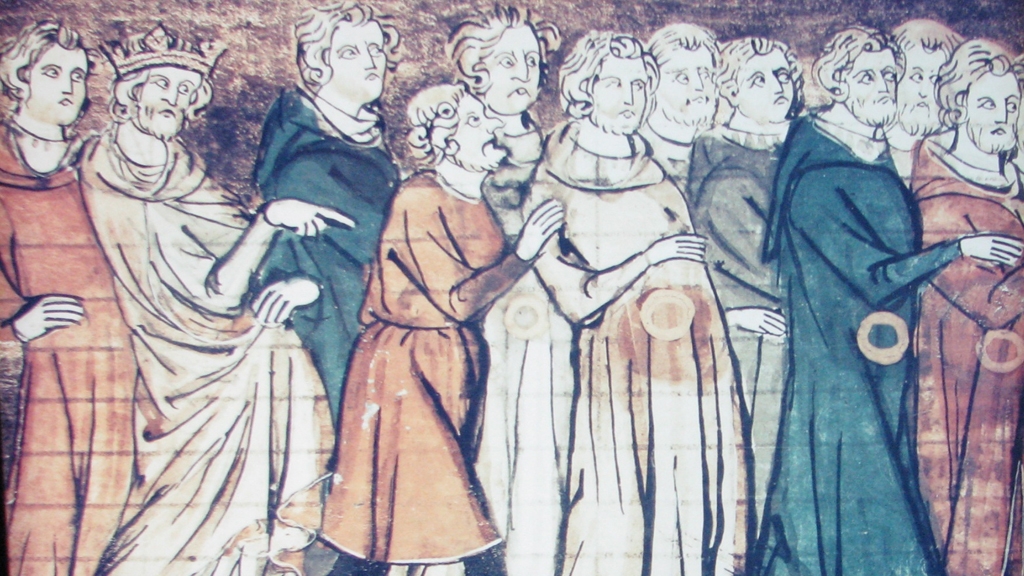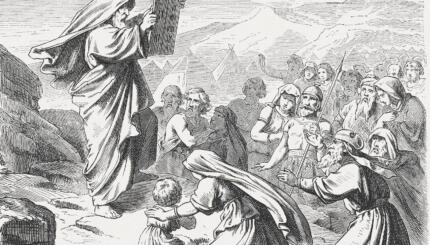Between 1290 and 1550, England, France, and most of southern and eastern Europe expelled their Jewish populations, at least once and sometimes several times (expulsion followed by readmission followed by expulsion). What did it mean to be “expelled”? How and why did expulsion emerge as a common expression of intolerance during this period?
Prior to the crescendo of expulsions that occurred in the 14th century, European Jewry experienced several brutal eruptions of intolerance, including, for example, the massacres that swept northern Europe in the wake of the Black Death (Jews were accused of poisoning the wells and thus causing the plague) and the The Great Conversion riots of 1391 in Spain, which resulted in the death of one third of the Spanish Jewish community.
These unprecedented incidences of violence resulted in an increasingly insecure existence for European Jewry in the later Middle Ages. For example, in the German lands, after the Black Death, Jewish settlement rights were more often than not limited in time to ten to twelve years, renewable and changeable at the discretion of the local ruler.
“A Civilized Way of Eliminating Jews”
It was in this context that expulsion, or banishment, became more common. Historian Salo Baron deemed it a “somewhat more civilized way of eliminating Jews.” Expulsion, he argued, certainly appeared legitimate, as it often amounted to the simple failure to renew an existing temporary residence permit. Baron also points to the medieval conception of Jews as permanent “exiles” as another way to understand the phenomenon of expulsion. While the exiles were tolerated in Christian communities as examples of Christian truth, this toleration could cease at the discretion of the local rulers.
Thus expulsion provided a “legitimate,” less violent way of eliminating the Jews from a region. But why eliminate them at all? The rationale for group expulsion was complex, but the most common reasons for doing so were economic and religious. When raising taxes failed to produce enough revenue for a local ruler, expelling a group and taking its land and possessions was often the next best alternative. (However, expulsion for economic gain proved counterproductive, as the loss of regular Jewish revenue depressed the economy in the long run.)
Popular anti-Jewish sentiment also fueled expulsions. In addition to the anti-Jewish witness theory, outlined above, rumors circulated regarding, for example, Jews killing Christians in mockery of the crucifixion (ritual murder), Jews desecrating the host (communal wafer), and Jews poisoning wells. (None of these rumors were true.)
In addition to economic and religious reasons for expelling the Jews in the late Middle Ages, historian Salo Baron adds his theory of nationalism and intolerance. Baron noticed that all of the regions that expelled the Jews during this period were evolving national states. In England, France, and the Iberian peninsula, argues Baron, the emergence of a national identity contributed to the decision to expel. In defining the national self, these states eliminated the most obvious “other,” the Jews. The expansion of two multinational states at the time–Poland-Lithuania and the Ottoman Empire– provided refuge for the exiles.
The following three examples of medieval Jewish expulsions include specific instances of the general circumstances outlined above.
In England, Jews Are Officially Out by 1290
Jews arrived in England from northern France shortly after William of Normandy’s 1066 conquest of the island. Under the reign of Henry I (1100-1135), Jews were granted a charter of protection, guaranteeing them certain liberties including freedom of movement, exemption from tolls, and recourse to royal justice. Despite the rise of anti-Jewish sentiment in the 12th century, most notably a ritual murder accusation in the case of William of Norwich in 1144, English kings continued to extend a charter of residence to the Jews.
Beginning with the reign of Richard the Lion-Hearted in 1189, the situation of England’s Jews declined. Constant warfare between England and France meant the Jews were taxed heavily. The situation grew worse for the Jews during the reign of Edward I (1272-1307), who forbade lending on interest in England, thereby depriving the Jews of their primary livelihood.
When the economy did not improve, Edward was confronted with a choice: confess the failure of his anti-Jewish policies or banish the Jews from England. He chose the latter: on July 18, 1290 (Tisha B’Av in the Jewish calendar), he issued an edict of expulsion. The Jews had to leave England by November 1, 1290. They were permitted to take their money and personal property; all of their real estate was turned over to the crown. The official Jewish presence in England ended. However, Jewish merchants soon returned and were tolerated because of the financial benefit they provided.
France: Four Centuries, at Least Five Expulsions
Establishment and rapid growth of French Jewry occurred between the 10th and 12th centuries. By the end of this period, French Jewish communities faced popular animosity, increased pressure from the Catholic Church, and higher taxes. The situation came to a head in April, 1182, when King Philip Augustus ordered all of the Jews to leave the royal domain (in this case, the area around Paris).
The Jews were permitted to sell their movable goods, but their real estate went to the crown, and synagogues became the property of the Church. Most Jews moved elsewhere in northern France. (The northern French Jewish communities were under the control of regional authorities.) In 1198 the Jews were permitted to return, but an additional tax was imposed on their activities.
From then on, French Jewish life was continually subjected to regulation and exploitation, primarily in the form of taxation to fund royal spending. Louis IX (1227-1270) forbade the Jews to lend money at interest, ordering them to live solely by their own labor in business. He also attacked Jewish intellectual life, outlawing the study of the Talmud on the grounds that it offended Christianity. Louis’s son, Philip III, maintained Louis’s policies and enforced ecclesiastical restrictions aimed at protecting Christians from Jewish influence.
The end of Jewish residence in Northern France occurred during the reign of Philip IV (1285-1314). After 1289, the Jews were expelled from Anjou, Maine, Gascony, and Nevers. Most of these Jews moved to Paris, where, even though they were subjected to restrictions, they were welcomed by the king. In 1306, Philip changed his mind and ordered the Jews to leave his realm. With no other choice, the Jews fled northeast to Flanders, east to Provence, or southwest to the Iberian peninsula.
Nine years later, King Louis X readmitted the Jews to France subject to certain conditions: the Jews had to purchase their readmission; they were not allowed to lend money (although pawnbroking was permissible); and they were forced to wear badges identifying them as Jews. But by 1321, Charles IV was unhappy with the revenue he received from the Jewish communities, and they were expelled once again.
Over the next 73 years, the Jews slowly moved back to southern France and re-established their businesses, until they were expelled for good by Charles VI in 1394.
Spain: the Most Famous European Expulsion
The most famous Jewish expulsion occurred in Spain in 1492. Spanish Jewry dates back to the late days of the Roman Empire. The community experienced an intellectual and cultural flourishing under Muslim rule. With the Christian reconquista (reconquest) of Spain, the Sephardim found themselves subject to the same animosity and pressures as their Ashkenazic brethren.
The decline of the Sephardim began in the middle of the 14th century. Higher taxes, a closer Church-state alliance, and popular anti-Jewish sentiment all contributed to this decline. The turning point came in 1391 when riots broke out in Seville. The violence quickly spread throughout Castile and Aragon, where the Jews endured over a year of attacks. Some Jews were forcibly converted; others felt that conversion was their only option. These Jews, known as conversos, were shunned by Jews and not fully accepted by Christians. In the 1440s, Spanish authorities realized that some of these conversos were returning to their Jewish heritage. To solve this problem, the Inquisition was authorized to find and deal with these backsliding Christians.
The conversos remained a problem in 1469, when Isabel, the sister of King Henry IV of Castile, married Ferdinand, the son of John II of Aragon. By 1479 they ruled Castile and Aragon together. Ferdinand and Isabel felt it was their duty to strengthen the standing of the Church in Spain, so they used the Inquisition to find conversos who secretly practiced Judaism. When the Inquisition did not produce the desired results, an edict of expulsion was issued. On March 31, 1492, the Jews of Spain were given four months to sell their property and leave the country. The reason given for this expulsion was simple: all prior attempts to stop Christians from returning to their Jewish roots had failed. Expulsion was the only way to guarantee that the Jews would have no influence on Christians in Spain.
Even though the root causes of these expulsions differed, the end result was the same: rulers profited, at least in the short run, from the expulsion of the Jews. Jewish merchants, officially or not, soon returned to England and France, where their financial contributions proved invaluable to the economy. In Spain, where the expulsion was for religious reasons, the Jews were not permitted to return. After 1492, Spain was officially a Christian nation with no religious minorities.
Talmud
Pronounced: TALL-mud, Origin: Hebrew, the set of teachings and commentaries on the Torah that form the basis for Jewish law. Comprised of the Mishnah and the Gemara, it contains the opinions of thousands of rabbis from different periods in Jewish history.



